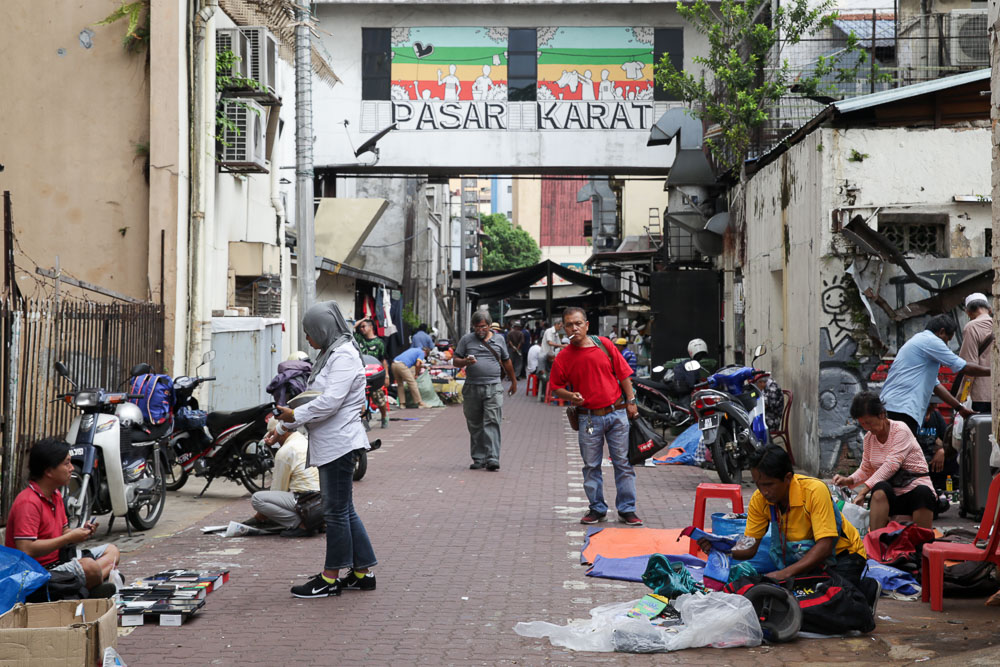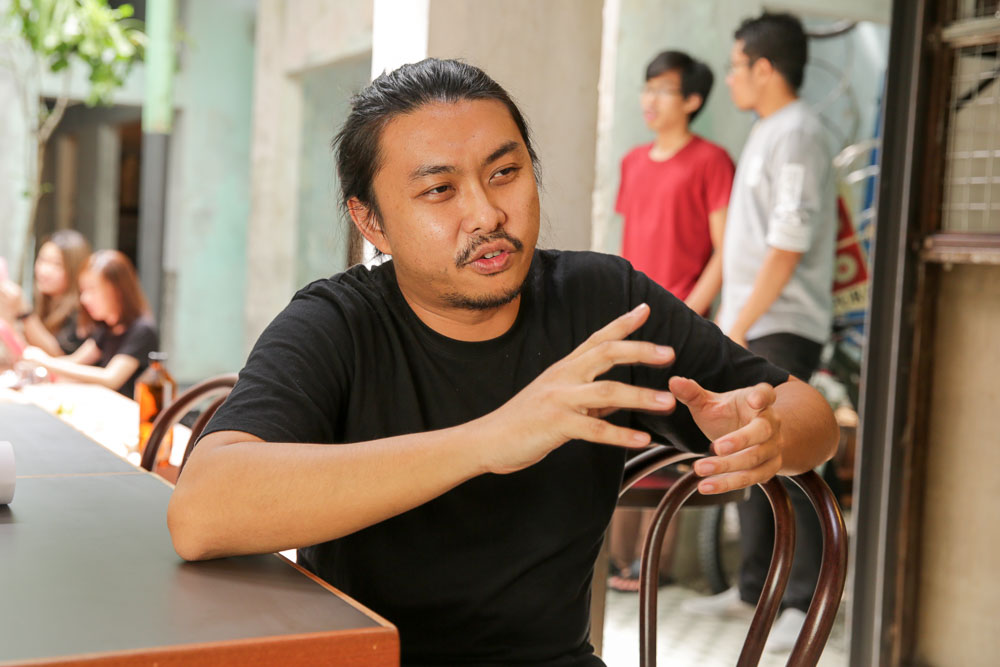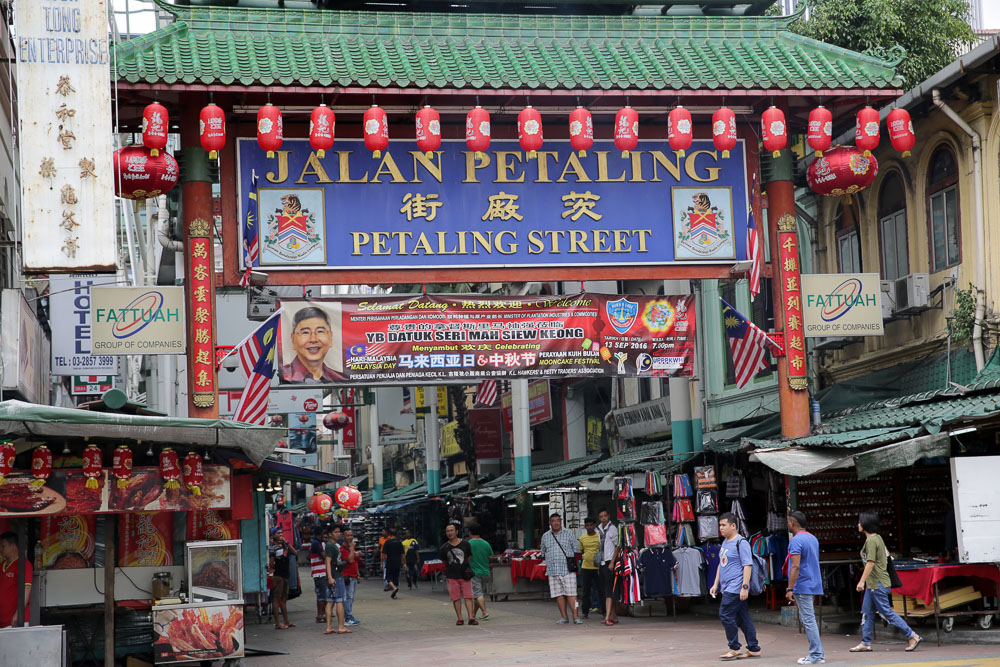KUALA LUMPUR, Oct 15 — There was once a time when there were more than a dozen stalls selling roast duck in Petaling Street, and this worried Choong Feng Phooi who sold the exact same thing from his humble kiosk.
Back then, reviews and recommendations came by word of mouth, not Facebook or Twitter, and most of these stalls had no signage.
So he wore glasses while roasting and preparing his special dish, and as his business became more popular, he became known as Sei Ngan Chai or quite literally the four-eyed/bespectacled man in Cantonese.
“Back in those days, a lot of people sold roast duck, but dad was the only one who wore glasses, and it eventually became a thing, and that was how people knew which shop was Sei Ngan Chai’s salted roast duck,” 40-something Amy Choong says with a shy grin on her face while wiping the sweat from her brow as she took orders from two regular customers who had come to collect their weekly fix.
It’s been a number of years since Amy took over the family business from her father, and although they now have a restaurant in Kepong she still operates the kiosk here daily at the same spot where her father toiled away for more than half a century.
“Is business good today?” I asked her, to which she shook her head nonchalantly.
“Last time business was much better. Back then it was simpler, people came and bought from us and went back. They knew what they wanted.
“Now it’s just old people or their children who come to buy roast duck for them... for nostalgia’s sake,” Amy says.
Tucked neatly in between rows of makeshift stalls selling counterfeit goods along Chee Cheong Kai (Petaling Street in Cantonese), Sei Ngan Chai is the only stall left today that still sells roast duck.
Others, according to Amy, have either had their businesses shuttered or simply chose to close shop because their children did not want to continue the family business.
End of an era
Don’t get the wrong idea. Petaling Street and its surrounds are by no means a ghost town. It remains bustling with activity and has a sense of purpose as its inhabitants are either traders selling their wares or travellers and visitors curious about what this place has to offer.
But what is noticeably different is the growing absence of its past, the old faces who breathe life and character into this historical spot in the heart of the capital city.
On Jalan Sultan, dust and grime cover the windows of Foto Pak Tai, an iconic photo studio which still bears a faded blue Konica signboard. Ironically, the Japanese photo company went out of business years ago. The sign on the door says the shop has relocated to the first floor of a building across the street.
Nearby, another iconic landmark — Popular Bookstore — closed its branch in Petaling Street this year after having served one million customers in the 13 years it was here.
“Business is dying, there is no business for us (old-timers) anymore. When I walk down Petaling Street now I don’t recognise it, the traditional shops have closed down and even the people have changed,” 65-year-old Uncle Lee says.
And he would know a thing or two about the changes. For decades, Uncle Lee ran the coffee shop in Hotel Lok Ann before it shut its doors back in 2013 to make way for the construction of the Mass Rapid Transit or MRT.
In April this year, he decided to open his own shop Onn Loke Kopitiam, a tiny coffee shop hidden in an alleyway just off Jalan Tun HS Lee that leads to the Chinatown wet market.
“Those days there were so many Chinese people around, now there are just different faces and different colours,” Uncle Lee says with a serious expression on his face, ostensibly referring to the influx of foreign workers setting up shop here over the years.
He believes the old businesses and trades in Petaling Jaya will eventually be replaced by hipster cafes and bars, and just like Sei Ngan Chai’s stall his customers consist of the elderly and regulars who know him personally.
“When I first opened this place it was busy, mostly regulars with some new customers curious about the history behind my cafe but now the hype has died down,” Uncle Lee tells me, to which a tattooed woman and elderly gentleman sitting nearby (his loyal customers) nodded in agreement.
There is a tinge of resentment in his voice when he speaks of the new businesses — the new so-called hipster cafes, bars and hotels — which have begun to replace the older establishments here.
“New cafes mushrooming here, they affect our business of course. All youngsters want air-conditioning, but the old people, they come here for familiarity,” Uncle Lee added.
Out with the old… in with the new?

For Chan Kam Weng, his pau (steamed bun) business has been a staple feature of Petaling Street’s lore for more than 40 years. The most part of his life has been spent making handmade pau as well as glutinous rice for his customers from a stall situated in a lane just off Jalan Sultan.
The routine suits him. At the crack of dawn, he’s already at his “back lane” stall, preparing his pau with the help of an assistant.
He says in the early days the alley used to be filled with other stalls selling different eats like char siew and mixed rice.
But for the past 10 years of so, there have been many changes; now his is the only stall left in the alley, save for an Indonesian trader or two selling cheap slippers or stolen wares.
“Nowadays, office people buy my food, not so much the tourists. Not so many stalls left either, owners are getting old and the kids have an education so they don’t want to take over,” the 52-year-old mumbles in Cantonese without looking me in the eye.
Chan is pessimistic about the future of Petaling Street and its people who have carved a living for so long here, and that it is only “a matter of time” before businesses like his become obsolete.
A main cause for his concern is the construction of Permodalan Nasional Berhad’s (PNB) 118-storey tower nearby, and how such a development might impact smaller and older traders like him.
“I am worried that my stall won’t be allowed here as it may not look pretty next to all the development.
“If they raise the rent after this, it’s okay but I am not moving from here. If I am forced to move, I will just close shop.”
Chan says he has no issue with the new cafes in the area, but won’t ever set foot in one because “the coffee in the cafes is no different from the kopitiam, both are black except that the second one costs more!”
The gentrification of Petaling Street? Reusing space; preserving heritage
In truth, the observation of traders like Uncle Lee and Chan are somewhat indicative of the changes taking place here, but it goes beyond the setting up of niche cafes or businesses that cater to younger Malaysians or tourists.
Undoubtedly, there are big development plans taking place such as the planned construction of major hotels like Four Points by Sheraton KL but besides that, there is an actual conscious movement to revive and preserve the charm and rustic quality of KL’s Chinatown.
Just off one corner of Jalan Sultan, an old double-storey shophouse in Chinatown which used to be a dilapidated, abandoned building frequented by drug addicts now serves as a restaurant-cum-backpacker hotel called Mingle. What’s more, its main structural integrity and design still remains fully intact.
And it is not the only building which is undergoing a revival of sorts.
Five minutes away is Chocha Foodstore, a cafe set up in what was previously the abandoned Mah Lian Hotel and a former brothel. Like Mingle, Chocha’s owners have maintained the building’s structural integrity as well as its heritage appeal.
While the issue of gentrification and its effects on an urban neighbourhood is debatable — the rise of property costs, displacement of original inhabitants — what is clear is that a growing number of entrepreneurs see the value in ensuring that the history and allure of Petaling Street is kept alive.
Architect Shin Chang, a co-owner of Chocha, believes in reusing the space of the former Mah Lian Hotel for a myriad functions while taking great pains to ensure that the building retains a glimmer of its former self.
And he has pulled it off quite well, so much so that there are no signboards from the outside of the building which reads “Chocha Foodstore.”
You have to pay close attention to locate the place. I would know... it took me half an hour to find it.
“As an architect, I wanted to regenerate the content of the building. I grew up in KL and I’ve always passed by this area.
“I used to look at this place and listen to everyone complain about how Petaling Street is full of foreigners now, everyone is just moving out,” Shin tells me.
“But now, I think it’s time for us to come back. It’s not just about generating revenue but creating an awareness.”

Using the Chocha building as an example, Shin explains his plans for the future; a bicycle workshop on the same floor as the cafe, a bookstore for local writers and artists, and a cocktail wine bar on the second floor.
His architectural firm, Mentahmatter, has already set up shop in the same building, along with a few other smaller firms.
“This is not just a restaurant, we have a few businesses here. We want this to be a venue for artists as well. The other day, we had a discourse session here about urban planning,” he says excitedly, adding that he feels that Chocha and by extension the Petaling Street area has the potential to be as successful as places like China House in Penang.
He takes his time to show me what he’s done with Chocha, and how he managed to maintain the pastel tiles and most of the raw concrete walls of the building.
“The roof was almost gone when I first saw the place… you can still see how the rain has affected some parts of the walls of the building,” he explains while pointing at the corner of a wall behind where a customer was seated.
The bigger picture
Shin says people need a reason to come back to Petaling Street, to invest their time and money in the area and they need to see how important a place like this is… steeped in culture, history and tradition.
“This is important. This the root of KL city centre, this is where KL started.
“People are going out, leaving because they want to move out… they don’t want to stay here. The younger generation don’t want to continue their parents’ business, but it’s this kind of business model (heritage revival) that generates the interest to come back and stay,” he says.
“So I try to do that, by keeping the essence of the past while at the same time moving forward.”
For Shin, renting out the space in Chocha is very much akin to the concept of Petaling Street’s old kopitiams, where different food stalls are given a space to operate while the kopitiam sold drinks.
Shin thinks the government should develop a sort of “co-housing development” plan for young working adults, and renovate some of the other buildings to serve such a purpose.
This, he feels, would encourage locals to live here and in turn bring a new lease of life to the area.
And what do the authorities feel about this?
They say they are open and receptive to the concept of reviving heritage buildings and turning them into businesses as long as they are operated by Malaysians.
“As for DBKL we are open. We can allow the new business but should be local operators. So land or building owners must also follow the rules and the building by-laws,” Kuala Lumpur Mayor Datuk Mhd Amin Nordin Abd Aziz said.



















